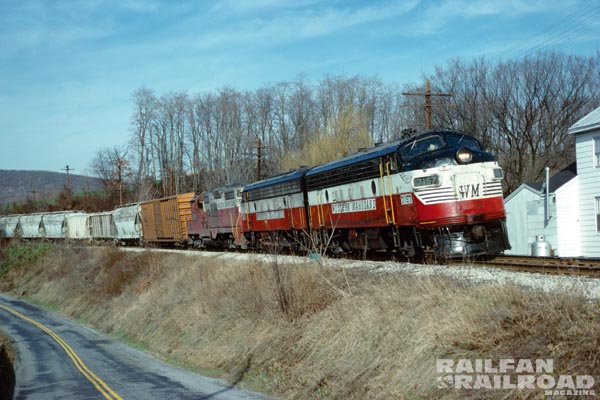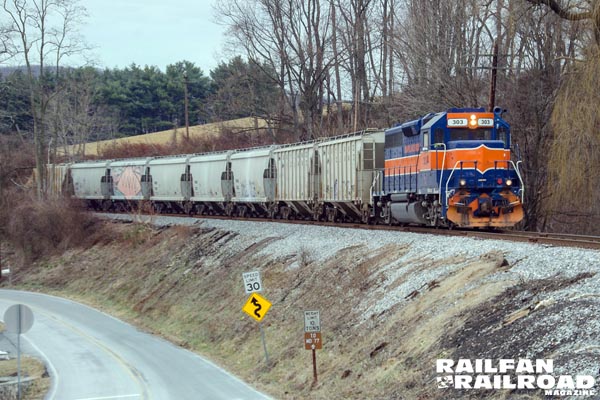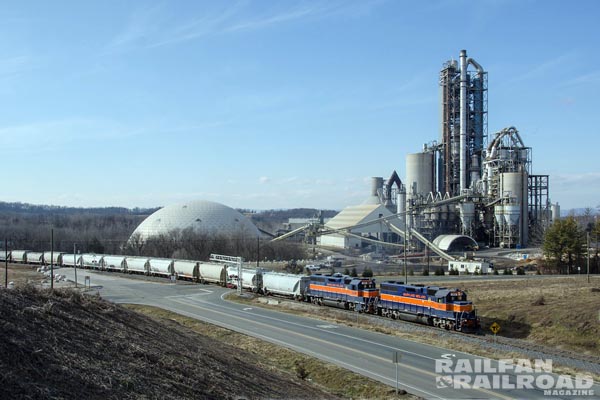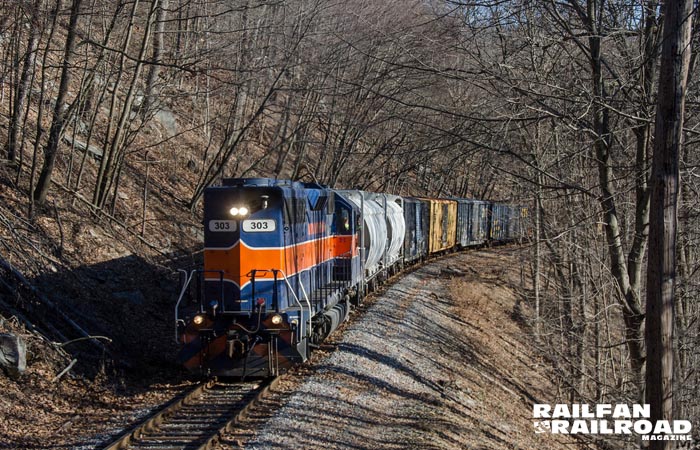By Steve Barry/photos by the author except as noted
Short line railroading is in a constant state of change. With corporations gobbling up profitable short lines, locomotives get shuffled around and paint schemes get standardized. The Maryland Midland (MMID) is a railroad about to undergo change — located in Union Bridge, Md., the MMID has been owned by Genesee & Wyoming Industries since 2007, and its locomotives will soon lose their blue and orange paint, replaced by G&W’s orange and black.
On January 17 I headed down to the Maryland Midland with my brother Bruce Barry, and we met up with Bill Kalkman there. Rumors of new paint were in the air, and we wanted to get one last hurrah of the old blue and orange. The railroad is shaped like a giant cross, with the east-west lines much longer than the north-south. The eastern end of the cross goes to Emory Grove, served on Tuesdays and Thursdays. while the west end goes to the CSX interchange at Highfield, served Mondays, Wednesdays and Fridays. The east-west line is the former Western Maryland main line, and the MMID began operations on this route in segments starting in 1983. The south line goes to a stone quarry, while the north line serves a single industry, and both of those see trains when the mood strikes. The north-south line is the original Maryland Midland, a former Pennsylvania Railroad branch that the MMID began operating in 1980. Indications were we’d get a train to Highfield, the most spectacular part of the line, on this Friday.
The Highfield line is the former Western Maryland main line, and makes a spectacular climb from Thurmont to Blue Ridge Summit, Penn. The train usually runs 20-30 cars or more, with four locomotives often leading. Anxiously we set up for a shot just west of the headquarters town of Union Bridge, waiting on the show. Imagine our surprise, however, when the train trundled by with a single unit, GP38-3 No. 303, and only three cars. To add insult to injury, the locomotive was backwards.
Undaunted, the chase was on. The train did not pause at Keymar (where the two lines of the cross connect), heading on towards Thurmont. We got another across the field shot near Rocky Ridge, then waited — a long time — in Thurmont. When the train arrived, we found that it had picked up a boxcar from a brickyard, and was pushing that boxcar in front of the engine. At Thurmont they shoved the boxcar into an industrial siding, ran to the other end of the siding and pulled out a long cut of cars, put the train together and headed up the steep grade towards Blue Ridge Summit. We set up on the grade for a shot (top of page). It would have looked (and sounded) a whole lot better if it had been a more typical big train with multiple locomotives.
At Sabillasville the tracks make a huge horseshoe around the town (it’s actually a part of a large “S” as the tracks swing back again up in the mountain above town). We set up for a shot of the train passing a mast where a Western Maryland signal was once mounted. There are several remnants of the WM along the line, including a couple of signals with the heads still in place.
After circling Sabillasville, the railroad briefly pops into Pennsylvania at the top of the grade at Blue Ridge Summit. The station is still here, now serving as the town library. As soon as the train crests the summit it heads back into the adjacent town of Highfield, Md., where the MMID connects to CSX’s ex-Western Maryland line that comes down from Gettysburg.
It is not uncommon for CSX to be in Highfield at the same time as MMID. This was not the case on this day. After dropping the cut of cars that had come from Union Bridge and Thurmont, the lone locomotive picked up a string of covered hoppers destined for the cement plant back at Union Bridge. We were about to get rewarded for our chase of a backwards locomotive — we would now have the locomotive facing the right way with good light on the nose for the chase back to Union Bridge.
 Changing times on the Western Maryland… (ABOVE) On December 16, 1978, Dennis Nehrenz captured classic cab units leading the Union Bridge local through Lantz, Maryland (See the January 2014 Railfan & Railroad to read the full story of Dennis’ two-day chase). Thirty-six years later, the Western Maryland is only a memory, but trains continue to climb the grade towards Union Bridge. Steve Barry caught up with the Maryland Midland on January 17, 2014.
Changing times on the Western Maryland… (ABOVE) On December 16, 1978, Dennis Nehrenz captured classic cab units leading the Union Bridge local through Lantz, Maryland (See the January 2014 Railfan & Railroad to read the full story of Dennis’ two-day chase). Thirty-six years later, the Western Maryland is only a memory, but trains continue to climb the grade towards Union Bridge. Steve Barry caught up with the Maryland Midland on January 17, 2014.
 After a challenging chase through the countryside, Steve Barry caught the Maryland Midland serving the Lehigh Cement plant at Union Bridge, Md., on January 17, 2014.
After a challenging chase through the countryside, Steve Barry caught the Maryland Midland serving the Lehigh Cement plant at Union Bridge, Md., on January 17, 2014.
Except we didn’t. High clouds moved into Highfield just as the train was ready to head back down the hill. We set up on the horseshoe curve at Sabillasville for a shot that wasn’t bad, but would have been a whole lot better in sun. Outside of Sabillasville we got another nice shot that would have been well-lit if the sun had been out. The clouds were beginning to thin out already, but luck wasn’t quite on our side. Finally, as the train arrived in Thurmont, the clouds thinned enough to put some light on the train. We shot it from a hillside adjacent to the cemetery on the west side of town.
I slipped coming down the hillside and landed on my back. Ouch. My camera went flying. Double ouch. However, I picked myself up, found my camera and cell phone (which had also gone airborne) and jumped back in the car. Our next location was near the brickyard. The sun was finally out!!! I put my camera to my eye, went to focus — and discovered I could not focus or set the f-stop. I missed the first properly oriented sunny shot of the trip! Back in the car I quickly deduced that the lens mount ring on my camera was damaged (again — I had first damaged it at the Cass Scenic Railroad last May), but if I held the lens firm against the ring, I could still shoot. The next shot was at Detour, Md., and this one I was able to get.

The sky was much improved, and we buzzed through Keymar and set up for a shot outside Union Bridge. The train took an unusually long time to get to us. The good news was the sun was out. The bad news was the train stopped at Keymar and picked up a flatcar, which it was now pushing ahead of the locomotive. The train would push back into the plant, where it vanished for about a half hour. That’s pretty typical for a run up to the plant. Finally the train came out and we were able to get the “money shot” from the adjacent hillside as it went past the plant.
The train headed down the hill and pushed back into the yard at Union Bridge. We asked the conductor if there was anything else going on that day, and he said this was it. Bruce and I said goodbye to Bill and we headed for Norfolk Southern in Pennsylvania. It was a challenging day on the Maryland Midland, and hopefully we’ll get back one more time before Genesee & Wyoming’s paint brushes get to the power.



